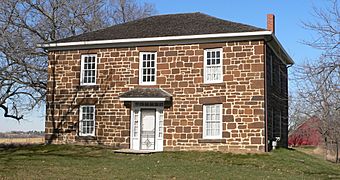Reverend George B. Hitchcock House facts for kids
|
Reverend George B. Hitchcock House
|
|
 |
|
| Nearest city | 63788 567th Lane in Cass County, near Lewis, Iowa |
|---|---|
| Built | 1855 |
| Architect | George B. Hitchcock |
| Architectural style | Federal |
| NRHP reference No. | 77000500 |
Quick facts for kids Significant dates |
|
| Added to NRHP | November 09, 1977 |
| Designated NHL | February 17, 2006 |
The Reverend George B. Hitchcock House is a historic house museum in Cass County, Iowa. It is located near the city of Lewis. This special house was built in 1856 by a minister named George B. Hitchcock.
The house was used as a secret "station" on the Underground Railroad. This was a network of safe houses and routes. It helped enslaved people escape to freedom before the American Civil War. Records show that Reverend Hitchcock helped shelter and transport these brave individuals. Because of its important history, the house was named a National Historic Landmark in 2006. Today, it is a museum where you can learn about its past.
About the Hitchcock House
The Hitchcock House stands west of Lewis, Iowa. It sits on a hill overlooking the East Nishnabotna River. The house is a two-story building. It was built using strong, local sandstone. The walls are very thick, about 21 inches (53 cm) wide. Inside, the house has large, hand-cut wooden beams. Its style is a simple version of Federal period architecture. This was a popular building style in the mid-1800s.
Secret Rooms and History
The house has some unusual features. One basement room seems to have been built on purpose for hiding people. Its entrance might have been hidden by a fake cabinet. Another basement room has a cooking fireplace. You could enter this room from outside or by stairs from above. Experts believe these secret rooms were used to shelter people escaping slavery.
Reverend George B. Hitchcock (1812–1872) built this house around 1855. He lived there from 1856 to 1865. When the house was built, it was near two main trails. These trails led to river crossings. Hitchcock was part of the abolitionist movement. This movement worked to end slavery in the United States. He offered a safe place for people escaping slavery on the Underground Railroad.
The House Today
After Reverend Hitchcock lived there, the property was used as a farm. In 1966, the state of Iowa bought the house. It went through a big restoration project in the 1980s. Today, the county manages the house as a historic museum. It teaches visitors about the Hitchcock family and the important history of the Underground Railroad.
See also



